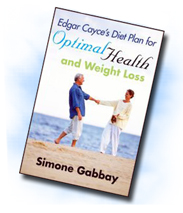Cayce diet 101: keeping the body alkaline
The recommendation to "keep the body alkaline" is a recurrent theme in the Edgar Cayce readings, and it is suggested that one of the ways we can achieve this is by centering the diet around alkaline-forming vegetables and fruits. We are advised that we can improve metabolic function, maintain a high state of health, and prevent colds, infections, and other illnesses by maintaining the body in an alkaline state. Reading 523-1 says, "Be mindful that the diet is such that it keeps.toward alkalinity for the body at all times; for this will not only prevent infectious forces but will aid in keeping the blood stream in such a manner as to aid in eliminations."
Today, more than half a century after the sleeping Cayce admonished that acidic conditions predispose the body to ill health, the notion of pH balance is finally catching the interest of health professionals and the general public, as more and more books and various health publications focus on the issue.
The pH scale is applied to measure acidity or alkalinity of body fluids. Its values range from 0 to 14, acid to alkaline, with 7 being neutral. For optimal health and metabolic function, most body fluids must be slightly alkaline. Blood should be at or near a pH of 7.4. Whenever the scale tips, the body mobilizes a special buffering system and draws on its alkaline reserve , consisting of mineral stores, to neutralize acidity. However, the minerals in the alkaline reserve must be replenished regularly through food. An alkaline-forming diet is therefore important.
All foods, after being metabolized, leave either acid- or alkaline-forming elements in the body. Alkalizing foods are those which supply predominantly alkaline-forming minerals such as calcium, sodium, magnesium, potassium, iron, and manganese. Most vegetables and fruits are in this category. Acidifying foods supply predominantly acid-forming minerals like copper, iodine, phosphorus, sulfur, and silicon. Meats, grains, and most fats and dairy products belong in this group.
Many charts have been published that list foods in the acid and alkaline categories. If we consult different ones, we are likely to find numerous discrepancies, partly due to differing research criteria or to actual variations of mineral values in foods, depending on where these foods are grown and whether or not they are refined. For instance, whole grains are less acid-forming than refined grains, from which the nutrient-rich germ and bran have been stripped away. Freshly picked, sun-ripened vegetables and fruits grown in organic soil are higher in alkaline-forming minerals than those grown in chemically imbalanced soil and harvested prematurely.
The best way to achieve an 80 percent alkaline-forming diet, as recommended by Cayce, is to build our meals around fresh vegetables and fruits, with smaller proportions of cereals, dairy, and meat than are typically featured in the North American diet. Ideally, all foods should be organically grown, whole, and unrefined, so that we can benefit from the full spectrum of nutrients and thus the alkalizing potential placed in the food by Mother Nature.
Most herbs (including herbal teas), spices, and food-based nutritional supplements, such as green-food concentrates, are alkaline-forming. Freshly extracted vegetable and fruit juices are highly alkalizing. I have often witnessed someone who felt weak and exhausted perk up and feel better within half an hour of drinking a large glass of fresh vegetable juice. Hot broths made from vegetables or chicken bones, as well as miso soup, which are all high in alkalizing minerals, have a similar effect.
Avoid fried foods, processed foods, and foods high in refined starches and sugars, which are highly acid-forming and rob the body of nutrients when they are metabolized. Alcohol, nicotine, and pharmaceutical drugs are also acid-forming. If tolerated, a small glass of red wine per day has medicinal value, but alcoholic beverages in excess upset the body's acid-alkaline balance.
In addition to diet, lifestyle factors also influence the body's pH balance. Stress, noise, environmental pollution, and lack of sleep and exercise all create acid conditions and ultimately disease. Prayer and meditation, restful sleep, and aerobic exercise such as walking, which pumps alkaline-forming oxygen into the body, are alkalizing and thus healing. Deep, abdominal breathing exercises are also recommended.
An easy way to test your pH balance is to use pH paper or litmus paper, which is available at many health food stores and some drug stores. This type of paper allows to test the pH balance of liquids, including body fluids. To test the pH of saliva, wet the end of the paper in your mouth and then watch the paper change its color. You will then be able to compare the color with samples shown on a color scale that indicates the matching pH level.
You can test your pH level at any time throughout the day, but you will get your most accurate values first thing in the morning. Test your values several days in a row. If your results indicate a level below 6.5, you can benefit from switching to an alkaline-forming diet and implementing the appropriate changes in your daily routine and lifestyle.

